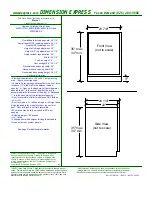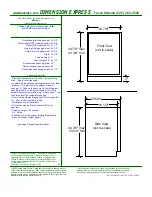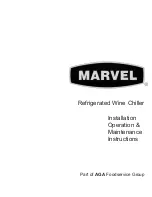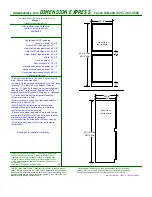
11
C
o
n
su
m
e
r
S
u
p
p
o
rt
T
ro
u
b
le
sh
o
o
tin
g
T
ip
s
O
p
e
ra
tin
g
In
st
ru
c
tio
n
s
S
a
fe
ty
In
st
ru
c
tio
n
s
In
st
a
lla
tio
n
In
st
ru
c
tio
n
s
C
a
re
a
n
d
C
le
a
n
in
g
Problem
Possible Causes
What To Do
Appliance has odor
Interior needs cleaning.
•
See
Care and cleaning
.
Moisture forms on
Not unusual during periods
•
Wipe surface dry.
outside of appliance
of high humidity.
Moisture collects inside
Too frequent or too long
(in humid weather,
door openings.
Wine bottles touching
•
Reposition bottles.
the back wall.
Frost forms on interior
This is normal.
•
See the
Defrosting
section.
surfaces of appliance
Door left open.
•
Excessive frost may form if the door is left open.
See the
Defrosting
section.
•
Door is not self-closing. Always make sure that
the door is closed after opening.
•
Check to see if a bottle is holding door open.
Appliance too cold
Temperature control
•
See
About the control and settings
.
is set too cold.
The room temperature where
•
For proper operation, the room temperature should
the appliance is located is
be equal to or greater than the set temperature
too cold.
of the appliance.
Temperature in the
This is normal.
•
After you set the temperature, the display will go
display is not the
back to showing the actual temperature.
temperature that
was just set.
Condensation on front
Appliance is located
•
Wipe off the condensation with a clean, dry cloth.
of door
in a high humidity environment.
•
Locate the appliance in a lower humidity
environment.
Water on floor behind
Door left open.
•
Door is not self-closing. Always make sure that
appliance
the door is closed after opening.
•
Check to see if a bottle is holding door open.
Tilting unit when moving.
•
This is normal. The drain pan above the compressor
may be full following defrost. Check to make sure
no water spills when moving the unit.
air carries moisture
into appliance when
door is opened)
ge.com
Summary of Contents for 197D4613P004
Page 16: ...16 ...












































